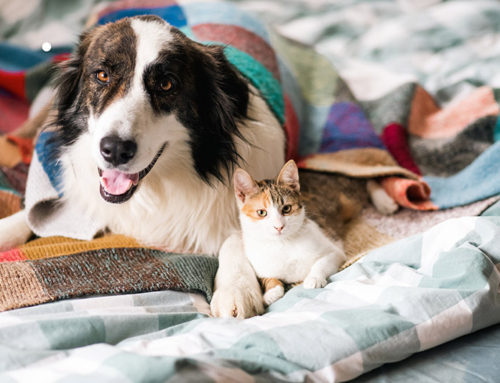Puppies often show their submission to older dogs and humans by urinating when approached. Some puppies also do this when overexcited and some continue this behavior into early adulthood. This submissive urination is most commonly seen in puppies and young female dogs. In most cases, it is a natural behavior that usually resolves as the puppy becomes older and more confident. However, uncontrolled urination can signal the presence of a urinary tract infection and a urinalysis is needed to rule this out as a medical cause of this behavior. Once this has been ruled out there are some things you can do to control submissive urination.
Treatment should focus on reducing the pet’s excitement and arousal, reducing fear and anxiety, and training for calm and relaxed greeting behavior.
• For submissive and fearful urination, it is important that the owner and all visitors interact with the pet in a less assertive or threatening manner. Approaches and greeting should be consistent and a loud tone of voice, sudden movements, reaching and direct eye contact should be avoided.
• All training should be reward based and physical restraint or physical punishment must entirely be avoided. It is important that a reaching hand is always considered to be a friendly and reassuring gesture by the puppy. A focused sit with eye contact should be part of the relaxation and settle exercises.
• If you catch your puppy in the act of house soiling, going into the garbage or chewing on something inappropriate, you might try a mild verbal reprimand, a noise device, a spray of water, or a pull on a long leash, but never anything physical. T
• The goal of training is to teach your dog to greet and be handled in a manner that does not lead to fear, submission, or excessive excitement. If you can avoid these reactions, the elimination might be prevented. At first you may be able to get your pet to display a behavior that it already does consistently without leading to urination.
• Consider what tricks or commands your dog does particularly well – shake a paw, sit up and beg, or fetch. You might throw a favored ball or treat so that your puppy learns to play when you enter or approach. If the dog anticipates food or ball playing at each greeting, it is less likely to eliminate.
• Another consideration is whether your dog might focus on a favored toy or treat or alert to a particular sound (e.g., squeaky toy, food jar). If this is the case you may be able to use these cues to get your dog to focus on something other than your approach.
• The goal is to replace the excited, fearful, and submissive responses with a settled method for greeting. At first you will need to identify and avoid those stimuli that might incite the behavior, while teaching your pet to sit and settle or go to its bed and relax to receive favored rewards. Use favored food rewards or toys as lures to train your dog to focus and settle. Gradually work to get a longer and more focused settle response.
• When greeting the dog, you should begin by letting your dog approach you rather than going to your dog. Kneel down rather than stand over the dog, speak softly, and pet the chest instead of the head. When greeting a very fearful or submissive dog, you may initially need to completely ignore it at greeting, even to the extent of avoiding eye contact. Allow your dog some time to settle down and only allow it to approach you if it is calm.
• By using a favored toy or giving a favored chew, you may be able to entice your puppy to approach or to allow lifting and handling while it takes the food or plays with the chew toy. As you pat or stroke your dog, be careful to avoid inducing further fear or submission; also, avoid letting your dog get too excited.
• For excitement urination, those stimuli that initiate the behavior should be avoided. During greetings, owners and guests should refrain from eye contact, physical contact, or verbal contact until the pet calms down. Greetings should be very low key and words spoken in a low, calm tone.
• The puppy might be taught to do an alternative behavior but the goal should be to practice a relaxed greeting (sit/focus or go to your mat). Stop and perhaps even walk away if the puppy starts to get excited.
• Another important aspect of treating over-excitement to visitors is repeated presentations of the stimulus, so that the dog learns the correct response. If visitors come only infrequently, the dog does not have the opportunity to learn a new behavior. By scheduling visitors to come, visit briefly, leave by another door and then re-enter, the dog may learn to be less excited and/or submissive with each entrance. Each time the person returns they are more familiar and less likely to stimulate the urination behavior. This allows the dog to “practice” the good behavior and reinforce the appropriate response.
• For refractory cases, the use of drugs to increase bladder sphincter tone might also be considered as an adjunct to behavior therapy.





